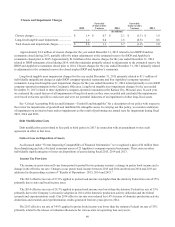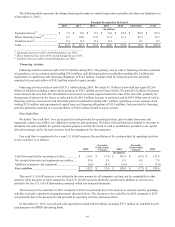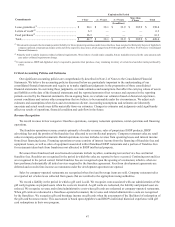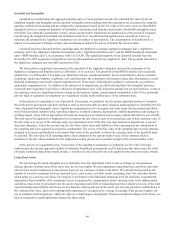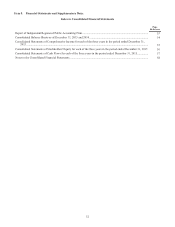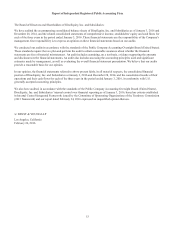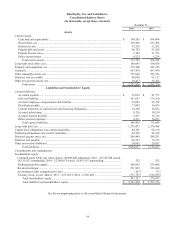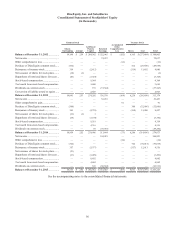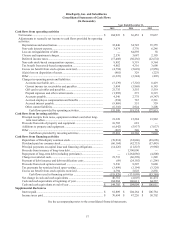IHOP 2015 Annual Report Download - page 69
Download and view the complete annual report
Please find page 69 of the 2015 IHOP annual report below. You can navigate through the pages in the report by either clicking on the pages listed below, or by using the keyword search tool below to find specific information within the annual report.49
On a regular basis, we assess whether events or changes in circumstances have occurred that potentially indicate the
carrying value of tangible long-lived assets, primarily assets related to company-operated restaurants, may not be recoverable.
Recoverability of a restaurant's assets is measured by comparing the assets' carrying value to the undiscounted future cash
flows expected to be generated over the assets' remaining useful lives or remaining lease terms, whichever is less. If the total
expected undiscounted future cash flows are less than the carrying amount of the assets, this may be an indicator of
impairment. If it is decided that there has been an impairment, the carrying amount of the asset is written down to the estimated
fair value. The fair value is primarily determined based on a discounted cash flow analysis.
Allowance for Credit Losses
The allowance for doubtful accounts is our best estimate of the amount of probable credit losses in our existing
receivables; however, changes in circumstances relating to receivables may result in additional allowances in the future. We
determine the allowance based on historical experience, current payment patterns, future obligations and our assessment of the
ability to pay outstanding balances. The primary indicator of credit quality is delinquency, which is considered to be a
receivable balance greater than 90 days past due. We continually review our allowance for doubtful accounts. Past due balances
and future obligations are reviewed individually for collectability. Account balances are charged against the allowance after all
collection efforts have been exhausted and the potential for recovery is considered remote.
Leases
Our restaurants are located on (i) sites owned by us, (ii) sites leased by us from third parties and (iii) sites owned or leased
by franchisees. For sites owned by or leased by us from third parties, we, in turn, sublease to our franchisees. At the inception
of the lease, each property is evaluated to determine whether the lease will be accounted for as an operating or capital lease in
accordance with the provisions of U.S. GAAP governing the accounting for leases.
The lease term used for straight-line rent expense is calculated from the date we obtain possession of the leased premises
through the lease termination date. We record rent from the possession date through restaurant open date as expense. Once a
restaurant opens for business, we record straight-line rent over the lease term plus contingent rent to the extent it exceeded the
minimum rent obligation per the lease agreement. We use a consistent lease term when calculating depreciation of leasehold
improvements, when determining straight-line rent expense and when determining classification of its leases as either operating
or capital. For leases that contain rent escalations, we record the total rent payable during the lease term, as determined above,
on the straight-line basis over the term of the lease (including the rent holiday period beginning upon our possession of the
premises), and record the difference between the minimum rents paid and the straight-line rent as a lease obligation. Certain
leases contain provisions that require additional rental payments based upon restaurant sales volume (“contingent rent”) that are
accrued each period as the liabilities are incurred, in addition to the straight-line rent expense noted above.
There is potential for variability in the rent holiday period, which begins on the possession date and ends on the restaurant
open date, during which no cash rent payments are typically due under the terms of the lease. Factors that may affect the length
of the rent holiday period generally relate to construction related delays. Extension of the rent holiday period due to delays in
restaurant openings will result in greater preopening rent expense recognized during the rent holiday period and lesser
occupancy expense during the rest of the lease term (post-opening).
For leases that contain rent escalations, we record the total rent payable or receivable during the lease term, as determined
above, on the straight-line basis over the term of the lease (including the rent holiday period beginning upon our possession of
the premises, if applicable), and record the difference between the minimum rent paid or received and the straight-line rent as a
lease obligation or receivable, respectively. Certain leases contain provisions that require additional rental payments or receipts
based upon restaurant sales volume (“contingent rent”). Contingent rentals are accrued each period as the liabilities are incurred
or receivables are earned, in addition to the straight-line rent expense or revenue, respectively, noted above.
Certain of our lease agreements contain tenant improvement allowances. For purposes of recognizing incentives, we
amortize the incentives over the shorter of the estimated useful life or lease term. For tenant improvement allowances, we also
record a deferred rent liability or an obligation in our non-current liabilities on the consolidated balance sheets.
Management makes judgments regarding the probable term for each restaurant property lease, which can impact the
classification and accounting for a lease as capital or operating, the rent holiday and/or escalations in payment that are taken
into consideration when calculating straight-line rent and the term over which leasehold improvements for each restaurant are
amortized. These judgments may produce materially different amounts of depreciation, amortization and rent expense than
would be reported if different assumed lease terms were used.



